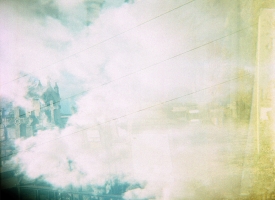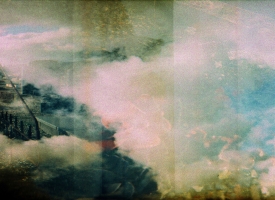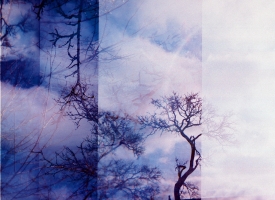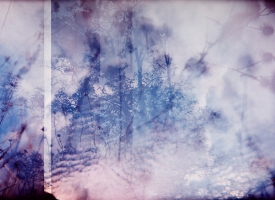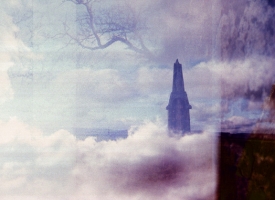FOSSOYEUR / GRAVEDIGGER
Project Description
In a small French village, a man sleeps in his lonely bed. Above him, bats in the rafters hunt the lacewing flies, whose severed wings float softly down upon him. In the morning, he tends to the women and girls who have been burned as witches by their neighbors – he is the burial man, the transfigurator, the body alchemist, taught to bury the meat in soil until it goes bone. His are the eternal questions of femicide: at what hour does the flesh forget? in what season does a murdered girl become something to plant seeds in? and under whose authority is what springs from it offered as food. Under all stages of sun and moon. Winter thistles rise from it, serrated as ribs.
Artist Statement
FOSSOYEUR emerged from several weeks working in a small medieval village in Vosges, in Eastern France. It was early winter, and with minimal electricity and heat I often woke early to go out into the white-dusted dawn, where ice crystals and hoarfrost turned the meadows and dead flowers into fairy lace. The residency was perched along the sides of an ancient pagan burial mound, between a Catholic convent and a small cemetery. One morning as I was walking along the outer walls of the cemetery and photographing the frozen thistles, a farmer in tall rubber boots came up with his donkeys and asked, of all the thistles in all of France, why do you photograph these thistles? He proceeded to tell me about the women of the village who were tried and burned by their Catholic neighbors, and how their bones were buried outside the edges of the Catholic sanctified cemetery. We walked with his donkeys up to the top of the mound, where he kicked at the dirt and revealed a carved prayer stone, which he said was a reminder of when witches and faeries had ruled the land.
Visual Art
FOSSOYEUR / GRAVEDIGGER was created in small villages in Languedoc and Vosges (France), at sites of witch burnings and burials. The photographs were created using salvaged German film cameras manufactured by female forced labor in Nazi concentration camps. The colors, textures, shapes and multiple layers within the photographs are all created using only the unique aberrations of the cameras’ optics, and the chemistry of the film. There is no software or computer manipulation in the images.
Photographs shown in solo museum exhibition at Yeshiva University Museum/NYC (August 1, 2011 – April 1, 2012)
THUMBNAIL GALLERY BELOW. CLICK TO VIEW FULL-SIZE PANORAMIC IMAGES.
Literature
FOSSOYEUR/GRAVEDIGGER
by Quintan Ana Wikswo
Translated into French by Jean-Jacques Poucel
First published in Drunken Boat
ONE
Who did they call to be burial man, the transfigurator. Who did they charge as the body alchemist, given the fleshy softness to make hard, who taught to bury the meat in soil until it goes bone.
Qui fut appelé fossoyeur, transfigurateur? Qui fut noirci en corps alchimiste ? A qui fut donnée pour la rendre dure la douceur incarnée? Qui apporta le savoir d’inhumer la chair en terre riche ? Qui devient ossement?
TWO
The village has more dead than living. They are stacked six deep, shallow in the dirt, and one must go for another to come.
Il y a plus de morts que de vivants dans le village. Six s’entassent sans profondeur sous la terre. On s’en va pour que vienne un nouveau.
THREE
In this time of trials, who did they call to be burial man, who charged as time’s transmogrifier. Who to know, then, when to take spade to loam, when to turn over the uterine-thickened mud – a woman corpse charcoal black between the hip bones, where the iron dwells.
Qui dans ce procès fut appelé fossoyeur? A qui la charge de transformer le temps? A qui donc le savoir de porter la bêche à terreau, de retourner la boue d’engrais utérin? Un cadavre de femme au bas ventre noir charbon où vient s’installer la ferraille.
FOUR
In the afternoon, he strikes at the bats that hang sleepily by day in the chimney vents. He shakes them down with blankets, and beats them into a thick clotted paste with his shoe.
En fin de journée il frappe vers les chauves-souris engourdies s’accrochant de jour aux capuchons de cheminés. Il les tape à coups serpillère,
les fouette en pâté caillot épais avec sa godasse.
FIVE
In this village, bones are found in every soup, and who ever stops to question the source of stock. He eats cherry pie, but there is no sweet of fruit in it. It tastes instead of afterbirth.
Les os apparaissent dans toutes les soupes du village et qui donc s’interroge sur l’origine du bouillon? Il mange la tarte aux cerises mais il n’y a aucun fruit doux dedans ; le goût est plutôt celui de placenta.
SIX
At night, the bats hunt in the roof beams above the gravedigger’s lonely bed. The bats hunt the crystalline lacewing flies, severing away the meaty thorax with a slice that frees the wings, which float down softly through the air.
La nuit, les chauves-souris chassent entre les poutres pardessus le lit isolé du fossoyeur. Les chauves-souris chassent les mouches aux ailles dentelles cristallines. Les thorax tranchés libèrent leurs ailles qui doucement dans l’air culbutent.
SEVEN
Who to harvest out the long white sticks of bone. Who the architect of body rock.
And who knew when to say: the burial soil is soft enough again, all organs gone, all hair, all nails. At what time is its fat fully rendered by bugs, at what hour does the flesh forget, in what season does a murdered girl become something to plant seeds in, and under whose authority is what springs from it offered as food. Under all stages of sun and moon. Winter thistles rise from it, serrated as ribs.
Qui fauchera alors les longs bâtons d’os blanc? Qui l’architecte des corps en pierre?
Qui saura quand dire le sol est déjà encore assez doux, que tous les organes ont disparus, tous les cheveux, tous les ongles? Laquelle est l’heure où les bestiaux auront assez bien fondu l’engrais? A quelle heure la chair aura-t-elle oublié? En quelle saison la fille assassinée sera-t-elle devenue ceci en quoi on sème? Sous quelle autorité ce qui en sort sera-t-il offert comme nourriture? Sous chaque étape de soleil et de lune. Les chardons d’hiver se redressent, des côtes en dents de scies.
Published in Drunken Boat
Film
Performance
Credits
FOSSOYEUR / GRAVEDIGGER created with the support of Haut de Fee Center of Serecourt, France.
Text and film by Quintan Ana Wikswo
Music composed by Veronika Krausas
First published in Drunken Boat
First performed and installed at Yeshiva University Museum / NYC
Available on the DVD collection “Prophecy of Place: Films of Quintan Ana Wikswo” by Catalysis Projects and Yeshiva University Museum.
With special thanks to Stacy Flood, Mieke Eerkins, Joanne Jacobsen, and Zachary Levine.


